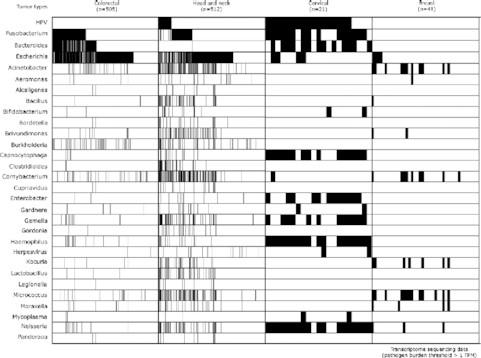
Fusobacterium nucleatum is associated with inflammation and poor survival in early-stage HPV-negative tongue cancer.
Desai S, Dharavath B, Manavalan S, Rane A, Redhu AK, Sunder R, Butle A, Mishra R, Joshi A, Togar T, Apte S, Bala P, Chandrani P, Chopra S, Bashyam MD, Banerjee A, Prabhash K, Nair S, Dutt A.
The role of pathogen-induced inflammation and its association with cancer initiation and progression is well established in various cancer types. However, systematic evaluation of persistent pathogen infection and their associated molecular and clinical features remains sparse. We present an in-depth infectious pathogen analysis of 349 whole exomes and 1,058 transcriptomes of samples derived from breast, lung, gallbladder, cervical, colorectal (CRC) and head and neck cancer (HNSC) patients of Indian origin and TCGA sample set.
In this study, in addition to known cancer-associated pathogens, like HPV in cervical and HNSC or Bacteroides, Fusobacterium and pathogenic Escherichia in CRC, we identify a significant prevalence of Fusobacterium in head and neck cancer (HNSC) samples, comparable to colorectal tumours. In the TCGA-HNSC tumors, Fusobacterium nucleatum occurs mutually exclusive to infection with HPV, which is known to have distinguished genomic and immune characteristics. Performing differential gene and miRNA analysis between Fusobacterium-high and low sub-group among the HPV-negative TCGA-HNSC tumours, we identified pathogen-specific deregulated molecular factors, including 118 inflammation pathway genes. Among the inflammation-related genes, we also observed a positive association of MMP10 expression with Fusobacterium burden.
We validate the Fusobacterium associated inflammation marker genes (IL1B, IL6 and IL8) and miRNAs (hsa-mir-451a, hsa-mir-675 and hsa-mir-486-1) identified in the genomic analysis. This evidence suggests a potential role of Fusobacterium associated inflammation in nodal metastases, especially in oral tongue tumours. The Fusobacterium-high sub-group of HNSC tumors also show enrichment of innate immunity cells (neutrophils, M2 macrophages, activated dendritic and mast cell), suggesting an inflamed, pro-tumorigenic microenvironment. Lastly, we demonstrate that the Fusobacterium burden is associated with poor overall survival and extracapsular spread in oral tongue tumours. Overall, this is the first comprehensive landscape of infectious pathogens across six tumour types and an exhaustive analysis of early-stage oral cancer samples of Indian origin. This study may have significant clinical implications especially in the HPV negative oral cancer patients.
